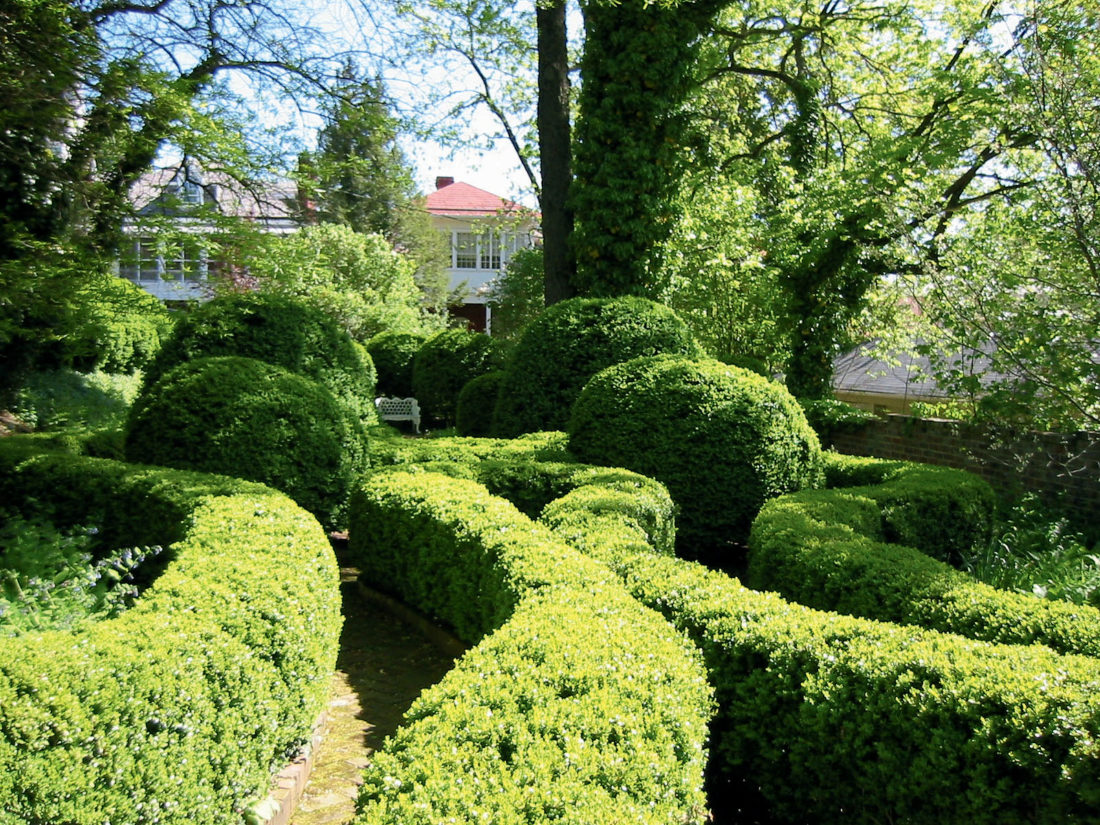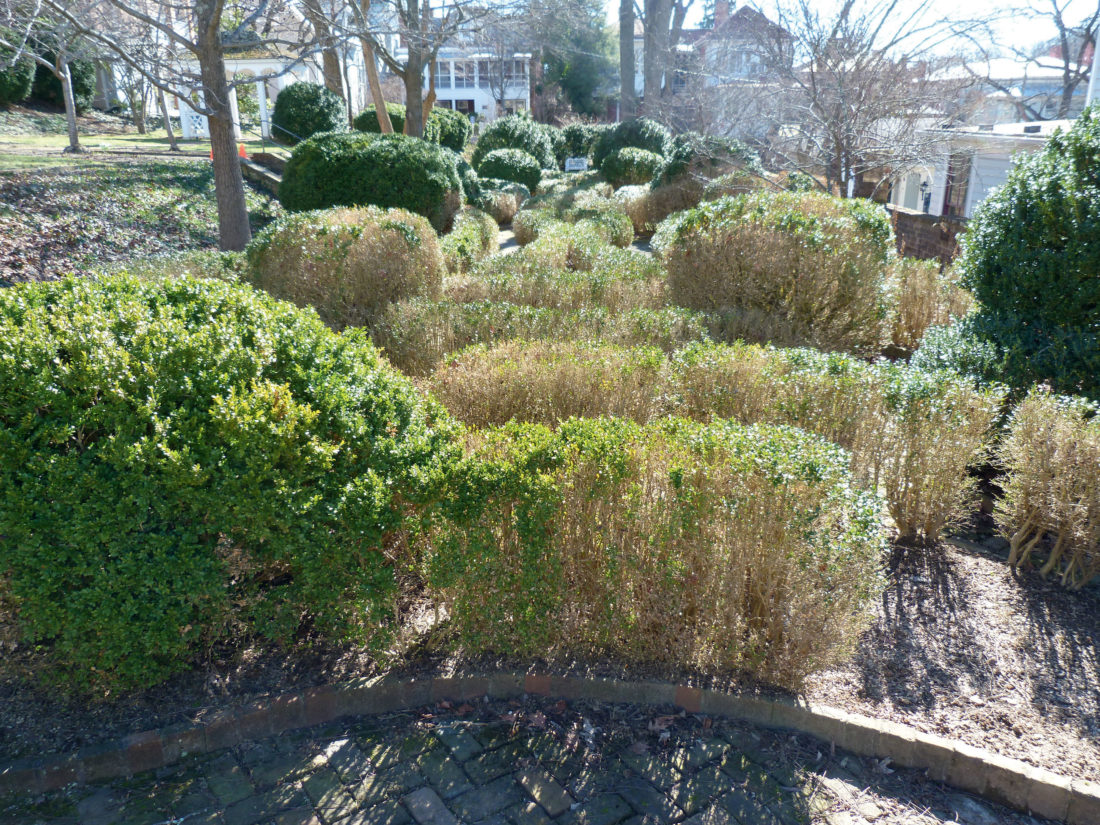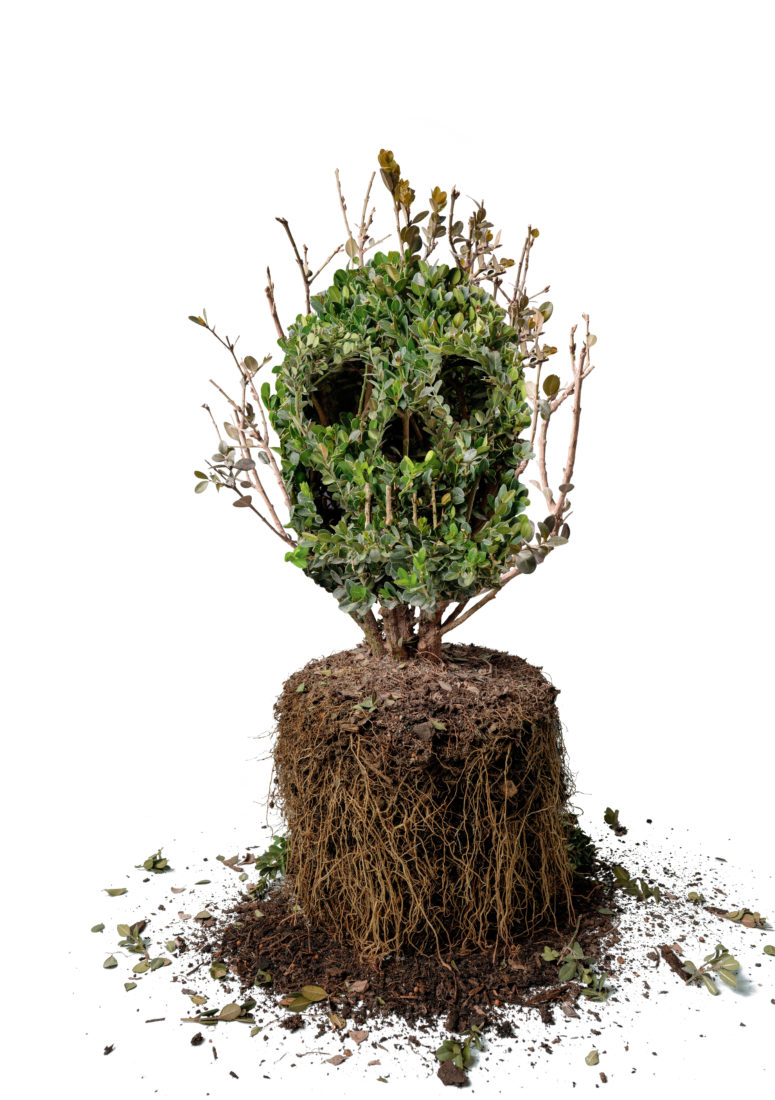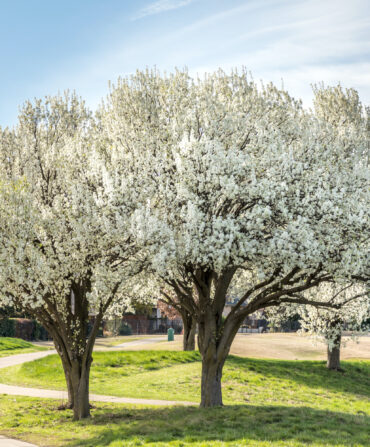Josh Meyer was ten days into his position as the director of buildings, gardens, and grounds at Tudor Place Historic House and Garden in Washington, D.C.’s Georgetown neighborhood when a staff gardener told him something was up with the boxwood. This was on a Friday last October, and Meyer, trained as a landscape architect, didn’t think much of the minor defoliation and leaf spotting. “But here’s where it gets crazy,” he says. “We came back on Monday, and the symptoms had spread to pretty much all the collection areas. You could see this thing just descending on the property.”
The “thing” was boxwood blight, a fungal disease wiping out generations-old boxwood with the heartless efficiency of an Ebola epidemic. Within weeks, the blight had stricken one-third of Tudor Place’s boxwood, leaving sections of the branches leafless and streaked with black cankers. Tudor’s gardeners, cloaked in disposable white Tyvek coveralls, removed the infected plants, leaf litter, and soil, taking care to double-bag everything to avoid spreading the spores,
a method they learned from the Virginia Boxwood Blight Task Force, whose members come from Virginia Tech and various cooperative extension offices. The scene was like something out of a creepy movie. “Boxwood blight looks horrible,” says Norman Dart, a plant pathologist with the Virginia Department of Agriculture and Consumer Services. “It scares people.”
As well it should. The fungus thrives in warm, wet weather and, when conditions are less than ideal, hunkers down and waits. It can survive at least five years dormant in the soil and probably longer. When spring rains come, the fungus showers plants with clusters of tiny white spores that consume the shrubs, browning leaves and blackening branches. The most susceptible variety—Buxus sempervirens Suffruticosa, the English boxwood, revered in the South for its use in parterres and topiary—defoliates within two weeks, so desiccated it looks as if it’s been burned.
Initially reported in the United Kingdom in the 1990s, the fungal pathogen Cylindrocladium pseudo-naviculatum first surfaced on this side of the pond in 2011 at a couple of North Carolina nurseries. State plant pathologists swooped in to identify and try to contain the blight, but they were too late. The spores quickly spread, destroying boxwood farms large and small. Kelly Ivors, a plant pathologist whose North Carolina State University lab first identified the fungus in the United States, remembers meeting a woman who had invested in boxwood farms for her retirement. The distressed woman said she was going to put the matter in God’s hands. “I was frank with her,” recalls Ivors, who now works for a commercial fruit grower in California. “I told her God was probably telling her that she wouldn’t be growing boxwood in five years.”
The spores, which also affect pachysandra and sweet box, are heavy and sticky. They don’t spread long distances by air, but they will splash from plant to plant, and they cling to clothing, animals, and garden tools. Around the time it was discovered in North Carolina, the blight showed up in Connecticut, and then Oregon and Virginia, probably transported through the nursery trade and even via ornamental wreaths shipped by mail. Since then, it has emerged in twenty-six states total, but mid-Atlantic spots such as Virginia, with its historic boxwood and ideal conditions for both growth and blight, have been hit particularly hard.
In 2015, boxwood blight decimated the crown jewel of the historic landscape at the Woodrow Wilson Presidential Library and Museum in Staunton, a bowknot garden designed in 1933 by Charles Gillette. Then last year’s record-breaking East Coast rains brought the blight back with a vengeance, and the property had to remove another seventy-six bushes. “We have zero boxwood now,” Robin von Seldeneck, the library’s president and chief executive officer, says, other than new test plants. “That left a lot of broken hearts in our community.” The 2018 epidemic affected countless private and public gardens across the state, from Williamsburg, to farms along the James River, to neighborhoods in Martinsville; some even resorted to burning the shrubs to address the blight.

Photo: Courtesy of the Woodrow Wilson Presidential Library Photo Collection
The bowknot garden at the Woodrow Wilson Presidential Library and Museum in Staunton, Virginia, before boxwood blight.

Photo: Courtesy of the Woodrow Wilson Presidential Library Photo Collection
The bowknot garden after boxwood blight.
Charles Stick, a Charlottesville landscape architect, calls the blight “extremely alarming, one of those earth-altering circumstances.” Stick has loved the shrub since his student days at the University of Virginia, when a first beguiling whiff of boxwood set him on a course of designing classically inspired gardens. “The talk around town,” Stick says, “is Well, I don’t think we should invite the Smiths to dinner because they’ve got boxwood blight, and they might bring it on their trousers.” Stick can relate. Boxwood, including a design propagated from sprigs plucked nearly a century ago from James Madison’s Montpelier, dominate the gardens at his own home, the historic Waverley Farm. Stick requires landscapers at Waverley to use disinfectant on their feet and equipment. “The garden is just too precious to mess around with,” he says.
Josh Meyer and his colleagues at Georgetown’s Tudor Place are working overtime to save their property’s centerpiece, an elliptical design of two-hundred-year-old plants whose thick, gnarled branches delight visitors. “If we had to replace them all with tiny boxwood, it would remove the last visual vestige of the 1800s understory,” Meyer says. Even swapping blighted shrubs for new ones isn’t foolproof, since the spores are so difficult to remove from soil. Some are choosing boxwood alternatives, such as certain holly varieties. Others, like the Wilson Library’s team, haven’t decided yet. “We want to keep the bowknot garden,” von Seldeneck says, “but we’re definitely not going to use boxwood.”
A new cultivar recently released by a Virginia nursery, however, may offer hope. Long before the blight landed on American soil, Bennett Saunders—among the third generation of owners of Saunders Brothers, a Piney River nursery that’s one of the largest boxwood growers in the South—worried about the fungus. For two years, he carried a scrap of paper in his billfold with the pathogen’s scientific name, scrawled down for him by a distraught Belgian boxwood grower he had met in the mid-2000s at a European Boxwood & Topiary Society meeting. When the blight finally surfaced in the United States, Saunders flew to Europe to prepare for battle, interviewing growers who had been fending it off for years.
Certain varieties, he learned, are more tolerant than others. So Saunders Brothers began sending samples of the 150-plus cultivars they had collected over the years to Kelly Ivors, the N.C. State pathologist, to test their susceptibility. For the past seven years, the nursery has been working to propagate the cultivars that resisted blight best, such as Green Beauty—a slow process because boxwood only grow two to three inches a year. Finally, at the Mid-Atlantic Nursery Trade Show in January, Saunders Brothers announced the imminent release of NewGen, its line of blight-tolerant boxwood. Under the most extreme pressure, the NewGen cultivars will show some lesions and leaf browning, but they tend to survive, especially when combined with proper plant management, such as mulching to suppress the spread of spores. The glossy-leaved NewGen Independence most resembles English boxwood. “It brings joy to my heart to see that Saunders Brothers has blight-tolerant boxwood that are commercially available,” Ivors says. “Without their collaboration, I don’t think we would be anywhere close to where we are today.”
“This is not a silver bullet, but we think it is a huge step forward,” says Saunders, who last year ripped out the English box from his own front yard and replaced them with NewGen Independence. “While I won’t see our new boxwood mature to the size and grandeur of what they are replacing, this is the fight of my life.”








